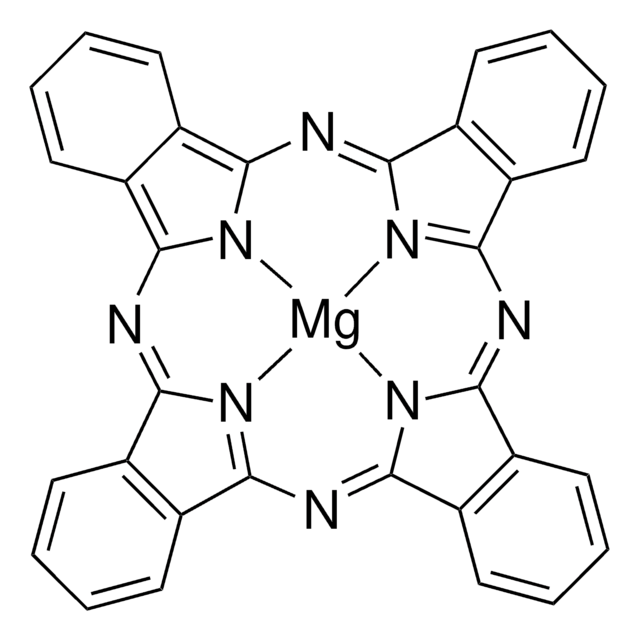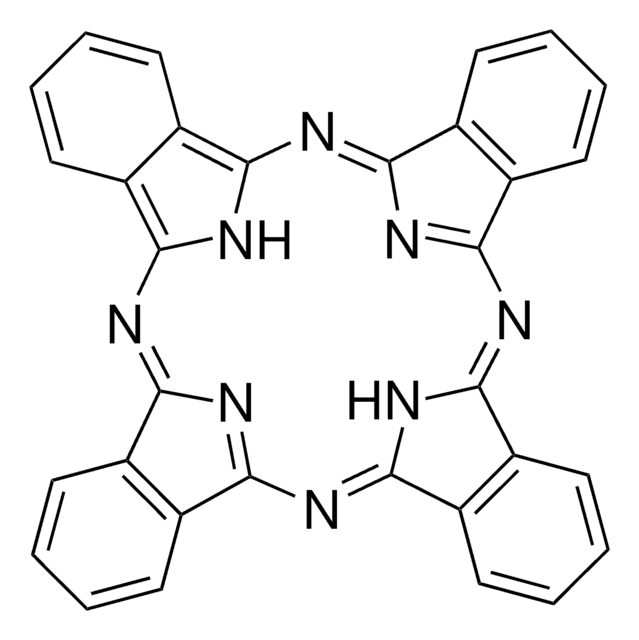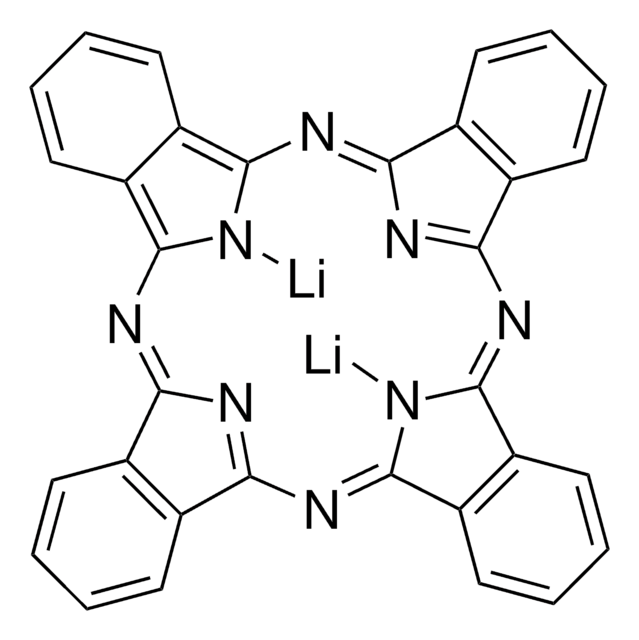추천 제품
설명
PL: 418 nm
μh ≈ 4.0 x 10−5 cm2 V−1 s−1
Quality Level
mp
>300 °C (dec.)
전이 온도
Tg >350 °C ((0.5% weight loss))
solubility
DMF: soluble
오비탈 에너지
HOMO 5.35 eV
LUMO 3.35 eV
UV 흡수
λ: 279 nm Amax
λ: 693 nm Amax
SMILES string
c1ccc2c3nc(nc4[nH]c(nc5nc(nc6[nH]c(n3)c7ccccc67)c8ccccc58)c9ccccc49)c2c1
유사한 제품을 찾으십니까? 방문 제품 비교 안내
애플리케이션
Phthalocyanine is a versatile functional dye with a range of intriguing properties enabling them to find practical applications in various disciplines from organic electronics, energy harvesting and biomedicine. Its derivatives exhibit semiconducting properties, making them valuable materials in organic electronics. They can be incorporated as active layers in organic photovoltaic cells, organic field-effect transistors (OFETs), organic light-emitting diodes (OLEDs), and other organic electronic devices.
Phthalocyanine, also known as H2Pc, is a versatile functional dye with a range of intriguing properties enabling them to find practical applications in various disciplines from organic electronics, energy harvesting and biomedicine.
In the field of organic electronics, H2Pc has been explored as a popular Hole Injection Layer (HIL) material for organic light-emitting diode devices (OLEDs).This special compound has also been explored for solar cells application given its robust and intensely colored macrocycles (blue pigments) with high chem., thermal and light stability, properties that are of paramount importance for realistic photovoltaic applications. H2Pc have attracted special attention as photosensitizers for dye-sensitized solar cells (DSSCs).
In biomedicine, phthalocyanine can serve as selective fluorescent probes for bioanal. and bioimaging, and as efficient photosensitizers for photodynamic therapy of cancer and other non-cancerous conditions.
In the field of organic electronics, H2Pc has been explored as a popular Hole Injection Layer (HIL) material for organic light-emitting diode devices (OLEDs).This special compound has also been explored for solar cells application given its robust and intensely colored macrocycles (blue pigments) with high chem., thermal and light stability, properties that are of paramount importance for realistic photovoltaic applications. H2Pc have attracted special attention as photosensitizers for dye-sensitized solar cells (DSSCs).
In biomedicine, phthalocyanine can serve as selective fluorescent probes for bioanal. and bioimaging, and as efficient photosensitizers for photodynamic therapy of cancer and other non-cancerous conditions.
관련 제품
제품 번호
설명
가격
Storage Class Code
11 - Combustible Solids
WGK
WGK 1
Flash Point (°F)
Not applicable
Flash Point (°C)
Not applicable
시험 성적서(COA)
제품의 로트/배치 번호를 입력하여 시험 성적서(COA)을 검색하십시오. 로트 및 배치 번호는 제품 라벨에 있는 ‘로트’ 또는 ‘배치’라는 용어 뒤에서 찾을 수 있습니다.
Spin-triplet-mediated up-conversion and crossover behavior in single-molecule electroluminescence
Chen, Gong, et al.
Physical Review Letters, 122, 177401-177401 (2019)
Turning Photons into Drugs: Phthalocyanine-Based Photosensitizers as Efficient Photoantimicrobials
Galstyan, A.
Chemistry?A European Journal , 27, 1903-1920 (2021)
Drug delivery systems for phthalocyanines for photodynamic therapy
Rak, Jakub, et al.
Anticancer Research, 39, 3323-3339 (2019)
Phthalocyanines for dye-sensitized solar cells
Urbani, M. et al.
Coordination Chemistry Reviews, 381, 1-64 (2019)
Electronic properties of CuPc and H2Pc: an experimental and theoretical study
Nardi, Marco Vittorio, et al
Physical Chemistry Chemical Physics, 15, 12864-12881 (2013)
자사의 과학자팀은 생명 과학, 재료 과학, 화학 합성, 크로마토그래피, 분석 및 기타 많은 영역을 포함한 모든 과학 분야에 경험이 있습니다..
고객지원팀으로 연락바랍니다.





